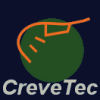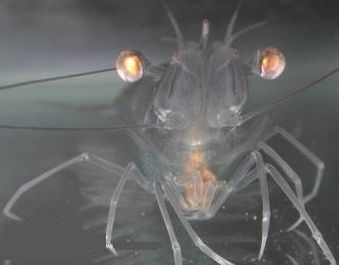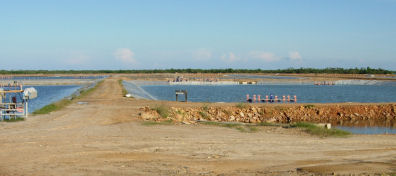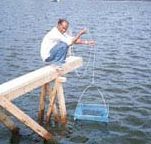|
|
 Introduction Introduction
Production of shrimp started a while ago in a very
extensive way. Wild postlarvae were stocked in ponds and natural
production in the ponds provided for the nutrition of the shrimp. To
increase the production per ha, stocking density was increasing and
artificial feeds were developed to complement the natural
production. As technology and feeds improved, production per ha
increased, but also the limits to the system became clear.
|
|
Shrimp differ in a lot to other farmed
species:  ·
·
- Shrimp are benthic. They only use the bottom of a pond.
- Shrimp must find the feed by chemical attraction
(olfactory sensors). Feeds should leach substances (often
useful nutrients) to attract shrimp to the feed.
- Typically, shrimp feed pellets will stay in the water for
15 - 60 minutes before the shrimp consumes them. But they can
lie in water for several hours before consumption and should
remain water-stable during this time. During this time, feed
pellets swell by taking up water and water-soluble nutrients leach
out of the pellets. These nutrients are a loss. In semi-intensive
farming, shrimp are typically fed 3-4 times/day. This worsens the
problem enormously.
- Shrimp are external masticators, meaning that they chew
their feed outside their mouth. They are selective
feeders, nibbling on pellets and only consume more feed when
palatability is OK: When shrimp start consuming feed, they will
not ingest the feed at once. They will nibble on it, select the
palatable pieces and throw away whatever they don’t like. The
uneaten parts are left and will be digested on the pond bottom by
bacteria.
- Shrimps are poor digesters. Their digesting system is
rudimentary. A lot of nutrients pass their system without being
assimilated. For example, the protein efficiency of shrimp is only
15-20 %.

- In nature, shrimps will consume a lot of pre-digested
feed, like rotten fish and detritus. Whatever is not
assimilated goes back to nature and is recycled. In ponds however,
as density of production increased, these excess nutrients became
pollutants, using oxygen and degrading into ammonia, hydrogen
sulphide and methane, all toxic to shrimp. To get rid of those
pollutants, water is exchanged and the pollutants are flushed out
of the system. This way, the chance of recirculating them is lost
and the feed will never be utilised at this maximum. This is the
main reason why feed conversions in shrimp culture are
horribly high and don’t show any progress during the last couple
of years.
- Shrimps can consume detritus actively or passively.
Soluble nutrients will dissolve in the pond water and feed the
natural bloom of the pond: phytoplankton, which in turn will feed
zooplankton. The shrimp will ingest some of this plankton again.
This is what we call natural production of the pond.
- Crustaceans have some unique nutritional requirements
such as phospholipids, cholesterol, Phosphate to Calcium ratio.
Knowledge of shrimp nutrition has increased during the years, but
application in business has been difficult. Semi-intensive farming
is not the system that will maximise shrimp efficiency and
different shrimp feed qualities have not show substantial
differences in the production. Hence, shrimp producers tend to
choose the cheapest feed.
|
|
 Feeding an
animal means giving the animal the nutrients it needs. The first aim
should be that the nutrients are actually ingested by the shrimp. As
a result a lot of effort has been made to make water stable
pellets, which can stay “intact” in water for several hours
without falling apart. Feeding an
animal means giving the animal the nutrients it needs. The first aim
should be that the nutrients are actually ingested by the shrimp. As
a result a lot of effort has been made to make water stable
pellets, which can stay “intact” in water for several hours
without falling apart.
However, it is not because the pellets
seem to be intact that they actually are. Pellets absorb water
(plus the salt minerals with it) and water-soluble nutrients
(vitamins, amino acids and peptides, ions) will leach
out.
To maximise nutrient re-utilisation, we have to
reduce water exchange. This can be done is different ways:
One
main factor is aeration instead of water exchange. The
nutrient recycling can be done in the same tank of in another tank
or pond. What could be called biological treatment of the pollutants
would be similar to what would happen in nature, meaning bacterial
flocks and substrates for nitrification.
Shrimps can passively
ingest and digest some of those bacteria and would graze on the
substrates to supplement feeds.
Nutrient recycling is then a
reality.
| |
 Introduction
Introduction  ·
·
 Feeding an
animal means giving the animal the nutrients it needs. The first aim
should be that the nutrients are actually ingested by the shrimp. As
a result a lot of effort has been made to make water stable
pellets, which can stay “intact” in water for several hours
without falling apart.
Feeding an
animal means giving the animal the nutrients it needs. The first aim
should be that the nutrients are actually ingested by the shrimp. As
a result a lot of effort has been made to make water stable
pellets, which can stay “intact” in water for several hours
without falling apart. 